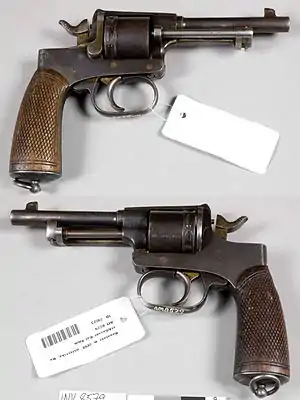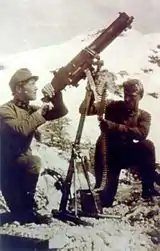Rast & Gasser M1898
The Rast & Gasser Model 1898 was a service revolver used by the Austro-Hungarian Army during World War I and various armies in World War II.
| Rast & Gasser M1898 | |
|---|---|
 Rast & Gasser M1898 Revolver from the Swedish Army Museum. | |
| Type | Revolver |
| Place of origin | |
| Service history | |
| In service | 1898–1945 1898–1918 (Austria-Hungary) |
| Used by | Austria-Hungary Kingdom of Italy Kingdom of Yugoslavia |
| Wars | Boxer Rebellion World War I World War II |
| Production history | |
| Designer | August Rast |
| Manufacturer | Rast & Gasser |
| Produced | 1898–1919[1] |
| No. built | Up to 200,000 |
| Specifications | |
| Mass | 935 g (2.1 lb) unloaded |
| Length | 223 mm (8.8 in) |
| Barrel length | 116 mm (4.6 in) |
| Cartridge | 8mm Gasser, 7.62 Nagant[2] |
| Action | Double-action revolver |
| Muzzle velocity | 240 m/s (787.4 ft/s) |
| Feed system | 8 round cylinder |
| Sights | Rear V-notch and front post |
History
180,000 copies were produced by the firm Leopold Gasser Waffenfabrik in Vienna from 1898 to 1912. The M1898 was planned to be replaced in the Austro-Hungarian cavalry by the Roth–Steyr M1907, and in the infantry by the Steyr M1912, prior to the outbreak of the First World War. However production of newer pistols was not sufficient and the weapon continued in service, especially issued to NCOs, officers and as a secondary weapons to machinegunners. In some armies it was used up through the Second World War, including Italy and Yugoslavia. The quality manufacture and the strength of the solid-frame design made it a reliable and consistent military weapon.
The M1898 was copied in Belgium by Manufacture d'Armes Liégeoise in 7.62 Nagant caliber.[2]
Operation
The Rast & Gassers featured some new elements of revolver design, as well as older elements already obsolete at the time of its manufacture. A solid-frame double-action revolver, it had a loading-gate through which individual cartridges are loaded, and extracted individually by an extractor rod. The firing pin was located on a transfer piece on the frame of the revolver rather than the hammer, an advancement at the time. Its ammunition is similar to but not interchangeable with that of the 8mm French Ordnance.
The cylinder could be removed by pulling down on the trigger guard and withdrawing the axis pin/ejector rod.
Loading
To load the M1898, the hammer is rotated back slightly until it is in the half-cock position. This safeguards against the hammer accidentally striking a cartridge while the user is loading the weapon. The loading-gate is then rotated back, exposing the rear of the cylinder. Doing this disengages the hammer from the trigger, but the cylinder will still rotate if the trigger is squeezed. This feature makes loading much easier and faster. Cartridges are then inserted into the cylinder and the trigger squeezed to rotate the cylinder for the next empty slot. After all the slots have been loaded, the loading-gate is closed by pushing it forward. The hammer is then rotated all the way back to the full-cocked position ready for firing.
To unload the M1898, the hammer is rotated back slightly until it is in the half-cock position. The loading-gate is opened and the ejector rod is pulled back to eject either spent casings or unused cartridges.
To remove the cylinder, the trigger guard is pulled down and the ejector rod-cylinder axis is then withdrawn and the cylinder removed.
Other Specifications
- Rifling: 4-groove right-hand twist
See also
Small Arms of WWI Primer 021: Austro-Hungarian Revolver M1898 Rast & Gasser covers the history of the gun, as well as disassembly and firing.
References
- http://www.gunsinternational.com/Rast-Gasser-1898-8MM-PR24354-.cfm?gun_id=100450757
- Richard Hammerfell (7 March 2015). Firearms Illustrated - A Visual Representation of Revolvers. Digital Services. p. 45. GGKEY:0BJ2PZD3N0U.
Sources
- D. VENNER, Le Grand Livre des Armes, J. Grancher, 1979
- COLLECTIF (spécialistes tchèques), Encyclopédie illustrée des Armes des 1ère et 2e Guerres mondiales, Gründ,2001
